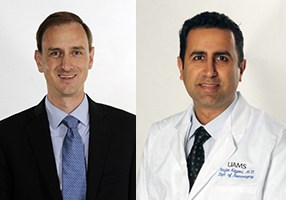July 1, 2020
UAMS First in Arkansas to Use ExcelsiusGPS™ for Robot-Assisted Spinal Surgery
July 1, 2020 | UAMS Medical Center is the first hospital in Arkansas to operate with the ExcelsiusGPS™ robotic spine navigation system that helps improve accuracy and reduce the invasiveness of spinal surgery.
Both the Department of Orthopaedic Surgery and Department of Neurosurgery use the new spine robot for patients needing spine surgery.
Noojan Kazemi, M.D., an associate professor of neurosurgery in the UAMS College of Medicine and director of the Spine Neurosurgery Program, performed the first procedure at UAMS with the ExcelsiusGPS™ robot. Kazemi specializes in using the latest and most innovative techniques in minimally invasive spinal surgery to perform all aspects of spine surgery, including degenerative, deformity and spine tumor surgery. He sees patients in the UAMS Neurosurgery Clinic.
David Bumpass, M.D., associate professor of orthopaedic surgery (left); and Noojan Kazemi, M.D., associate professor of neurosurgery
“In minimizing our incisions and dissection pathway, we are able to allow faster recovery time and, hopefully, better and faster healing,” Kazemi said. “For patients, this could mean less time in the hospital and a greater chance of returning to a fully functional life more quickly.”
David Bumpass, M.D., associate professor of orthopaedic surgery, has also used the system to assist with an emergency back surgery on a patient who was in an accident.
“The patient had a severe spinal pelvic injury that needed stabilization, and it was an ideal situation to use the robot, which enabled us to perform the surgery much less invasively than we would have before. That’s in an area of the body with a lot of muscle and an open incision would have meant a difficult recovery for the patient, who already had a long road ahead because of their other injuries. But I was able to do the case with just a few small incisions and a high degree of accuracy. So even in our first case, it really met and exceeded our expectations.”
Kazemi said the system helps surgeons plan the surgery in advance to find the best path given the unique anatomy of each patient. The ExcelsiusGPS also combines the precision of robotics with the advantage of navigational feedback in real time. The surgeon can guide each step while watching live scans of the patient’s anatomy in interaction with each procedure. Research shows the ExcelsiusGPS to be incredibly accurate at screw placement and that it reduces the time spent in surgery compared to other minimally invasive methods. In addition, the surgery can be planned ahead of time on the robot to allow for accurate and faster placement of the spine instrumentation during the operation itself.
“Accuracy has always been one of our biggest issues in spinal surgery, and it’s vitally important to the success of the patient’s experience after back surgery,” Kazemi said. “There are many important structures in that part of the body — the spinal cord, peripheral nerves, nerve roots, and so on — so we always need to optimize our surgical precision as much as possible. Robot-assisted surgery is helping us achieve that.”
Bumpass said the system has both immediate benefits and long-term promise.
“The immediate benefit we see is that it is more minimally invasive and more accurate in terms of placing these screws into areas where there are important nerves in the spinal cord and vascular structures,” Bumpass said. “In the future, we are excited to see how the technology will continue to evolve, whether that begins to incorporate augmented reality or other exciting technologies. Robot-assist is perfect for increasing speed and accuracy, and those are the areas where we are excited to see what the future holds.”
Kazemi said robotics is bringing major advances and great promise to the field of neurosurgery.
“What’s exciting for me about the robot is not just where it is right now, but some of the functions that it will be able to perform in the future,” Kazemi said. “UAMS is a teaching hospital and a research institution, and it is part of our mandate to stay at the forefront of innovation. I am glad we are able to bring robotic-assisted spinal surgery to Arkansas and be part of the scientific effort to help develop and teach this technology — as well as benefit our patients with the latest techniques available anywhere.”
Bumpass agreed.
“We know that robotics is the next iteration of technology in spine surgery is going to push the field forward,” Bumpass said. “The fact that we’re the main academic institution in Arkansas means we need to stay at the forefront of these technology changes that can bring better outcomes and faster recoveries for patients. We are excited to see how this technology grows and evolves and eager to be a part of pushing innovation forward.”

